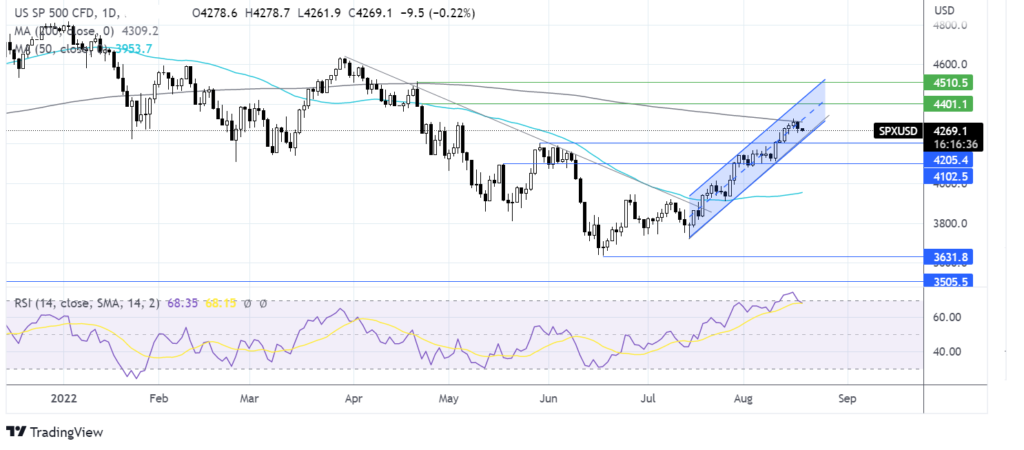Fed minutes hurt stocks and eurozone inflation is due

S&P500 => The index falls back from 4300
Oil => The commodity rises towards $90 per barrel
EUR/AUD => The pair rises towards 1.47
S&P500 struggles after FOMC minutes, jobless claims next
The S&P500 closed 0.7% lower yesterday amid renewed growth concerns and after retailer Target dragged the retail sector lower.
Target reported a 90% drop in earnings as inflation hit customers spend less. Retail sales data was also softer than expected, showing unchanged growth in July after strong growth in June. The strong jobs market is likely to support sales, even as prices remain stubbornly high.
The minutes of the latest Fed meeting were hawkish showing that the Fed remains intent on hiking rates further, which is bad news for stocks. Today attention shifts to jobless claims. The market will watch to see if initial jobless claims continue to climb. Signs of weakness in the jobs market could unnerve the market and pull stocks lower.

US retail sales MoM July Actual: 0% (0.8%) Previous: 0.8%
Where next for S&P500?
The S&P500 has been trading in a rising channel since mid-July as it extends its recovery from 3700.
The price has risen over the 50 sma and has run into resistance at the 200 sma. The RSI had moved into overbought territory and is easing back below 70. Buyers need to break above the 200 sma at 4309 to extend the bullish run towards 4400, the April 22 high, and 4513, the April 21 high.
Failure to retake the 50 sma could see the price fall back to test 4208, the late May high, and the lower band of the rising channel ahead of 4100, the May 17 low.
Oil rises from a 6-month low
Oil prices rose from a six-month low yesterday and are holding steady heading to the European open as investors digest a larger than expected draw on US crude oil inventories, rising output from Russia, and a possible global recession.
Oil prices fell to a low of $85.73 earlier in the week as weak global economic data raised fears of a recession, hurting the demand outlook. On the supply side, Russia has started to increase oil production as Asian buyers have increased their purchases.
Meanwhile, data showed that US crude oil inventories fell by 7.1 million barrels according to the EIA, much more than the 275,000 forecast. Any developments surrounding the revival of the Iran nuclear deal will be watched carefully as this could see more oil released into the market.
EUR/AUD looks to EZ inflation data
EUR/AUD jumped 1.4% in the previous session as the euro shrugged off a downward revision to Q2 GDP growth.
Meanwhile, the Aussie dropped sharply following weaker than expected wage growth in the April to June quarter. While wages grew at the fastest rate in 8 years in Q2, this was still below forecasts and well behind inflation. Jobs data also surprised to the downside with a fall in employment change.
Softer wages and jobs data are prompting speculation that the RBA could slow the pace at which it raises interest rates. Today attention shifts towards eurozone inflation, the final reading before the next ECB meeting in early September. Inflation is expected to reach a record high, piling pressure on the ECB to hike rates more aggressively.
EZ CPI July Expected: 8.9% (0.3%) Previous: 8.6%
Aus. Employment Change Actual: -40.9k (129.3k) Previous: 88.4k
Support can be found at 1.4625 (20 sma) and 1.44 (August low).
Resistance for the index can be seen at 1.48 (August high) and 1.4875 (50 sma).
